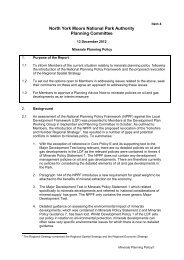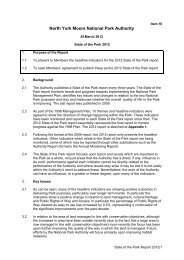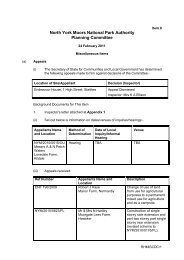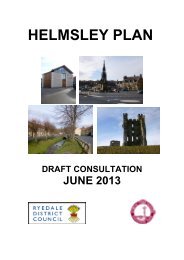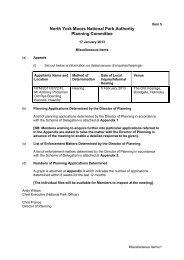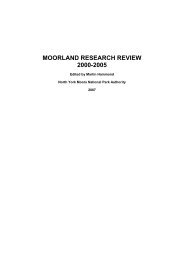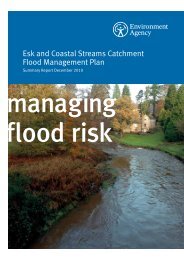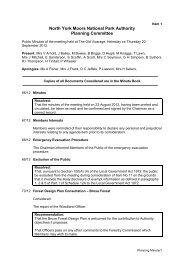Lowland wetlands - North York Moors National Park
Lowland wetlands - North York Moors National Park
Lowland wetlands - North York Moors National Park
Create successful ePaper yourself
Turn your PDF publications into a flip-book with our unique Google optimized e-Paper software.
Threats<br />
<strong>North</strong> <strong>York</strong> <strong>Moors</strong> <strong>National</strong> <strong>Park</strong><br />
<strong>Lowland</strong> Wetland Habitat Action Plan<br />
2008–2012<br />
Odontomyia hydroleon#<br />
• Drainage to improve the value of land for agriculture has been the major<br />
cause of decline in lowland wetland habitats in the <strong>National</strong> <strong>Park</strong>.<br />
• Valley fens are particularly susceptible to pollution. Eutrophication from<br />
fertiliser run-off leads to increased plant growth and reduced species<br />
diversity. Trapped silt can dry out wet habitats, and toxins from agricultural<br />
chemicals can kill associated wildlife.<br />
• Many wetland sites are no longer being actively managed through grazing or<br />
cutting and many of these are showing an increase in coarse vegetation and<br />
encroachment by willow and alder scrub.<br />
• <strong>Lowland</strong> <strong>wetlands</strong> are not currently seen as a valuable agricultural resource<br />
and payments for maintaining them under agri-environment schemes often do<br />
not reflect their importance to wildlife or the cost of their management to the<br />
farmer.<br />
• There is a lack of up-to-date knowledge concerning the distribution and<br />
condition of lowland <strong>wetlands</strong> in the <strong>National</strong> <strong>Park</strong>, so valuable sites can be<br />
inadvertently lost.<br />
• <strong>Lowland</strong> wetland habitats cover a small total area in the <strong>National</strong> <strong>Park</strong> and<br />
have a highly fragmented distribution. Associated populations of plants and<br />
animals are vulnerable to local extinction because of their small size and the<br />
lack of connectivity.<br />
Requirements<br />
• Inappropriate drainage systems can be deliberately broken up to allow<br />
flushes and marshy grassland areas to redevelop.<br />
• Sensitive livestock grazing and/or cutting regimes are needed to keep<br />
invasive species and scrub at bay whilst breaking up, but not poaching, the<br />
soils and allowing the majority of plants to set seed in at least one year in<br />
three. Cattle and ponies may be particularly useful for this task.<br />
• Continuity of low-input management should be maintained, with the<br />
application of no inorganic fertiliser, no manure and no herbicides.<br />
• Invasive weeds such as creeping thistle and bracken may need to be topped,<br />
trampled, weed-wiped or spot-sprayed to prevent their spread.<br />
• Scrub should be managed to prevent it encroaching on wetland areas. Where<br />
wet woodland is an important component of the habitat, a diverse scrub edge<br />
zone should be encouraged.<br />
• Leave wide arable margins as buffer strips to adjacent <strong>wetlands</strong>.<br />
• Funding is needed for wetland restoration tasks to be carried out and to<br />
ensure the conservation management of a wetland network.<br />
• Further survey work is needed to identify wetland areas within the national<br />
park.<br />
Current Local Action<br />
• In agri-environment schemes, such as Countryside Stewardship,<br />
Environmental Stewardship or <strong>National</strong> <strong>Park</strong> schemes, land managers agree<br />
3 of 5




